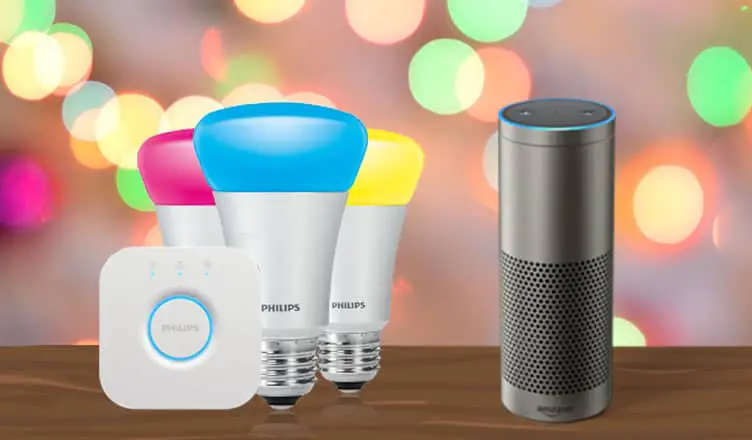Using Alexa, you can turn lights on and off in your home with your voice. Here’s how to set it up.
The Alexa voice assistant can do a lot more than just tell you what the weather is, set timers, and play music.
With a couple more accessories, you can set up Alexa to turn lights on and off for you. You can also schedule individual light bulbs or entire groups of bulbs to turn on and off automatically with Routines.
We will also explain what you need in terms of hardware, and how to use Alexa to set up routines using the Alexa app for iOS and Android.
Step 1 – Setting up smart bulbs
Before you can start controlling your lights with Alexa, you need to set up some smart bulbs. We recommend the Philips Hue Starter Kit, which comes with two A19 LED light bulbs and a bridge that connects them to your home Wi-Fi network.
You can also add smart bulbs in non-traditional places like under your kitchen cabinet or your nightstand lamp. For more help setting up smart lights, check out our comprehensive guide here.
Step 2 – Connecting Hue with Alexa
Now that you have smart bulbs, it’s time to connect them with Amazon Echo devices. First, download and install both Philips Hue and Amazon Echo apps on your mobile device of choice. Then follow these steps in order.
Step 3 – Using Echo with Hue:
Now that you’ve connected your smart bulbs with Amazon Echo, let’s walk through a few useful commands and features.
First, you can control your lights in three ways: asking for a color/color temperature/brightness; asking for a specific preset on each bulb (ex: Alexa, turn on bedroom light); or by using voice triggers like good morning.
Step 4 – Turning lights on with commands
Alexa can be accessed on Android, iOS and Amazon Fire tablets. Those with Amazon Echoes will probably already have the app on their devices.
Install and set up your light bulb, plug or switch before you can turn them on. In some cases, you’ll need to download the manufacturer’s app, create an account, and set up the device there.
- After that, open the Alexa app and follow these steps:
- At the bottom, tap on Devices
- Tap on the + icon at the top right
- To add a device, tap ‘Add Device’
- Choose the type of device you are setting up (light, plug, or switch).
- From the list, choose the brand you want
- Follow the screen instructions
Connect the account for the device (such as Philips or TP-Link) with your Amazon account and authorize Alexa to use it.
Once you set up your plug, switch, or light, you should see it when you tap on Lights, Plugs, or Switches in the Alexa app.
Tap on the device in the list, then tap the cog icon (top right) and then tap Edit Name to rename it. Do this by tapping the device’s name, then tapping on the cog icon (top right) and then tapping Edit Name.
You can use voice commands to turn on and off your compatible lights. To do this, just say “Alexa, turn on the light” or “Alexa, turn off the light”. You can also ask Alexa to dim your lights or set them to a specific brightness.
For example, you could say “Alexa, dim the living room light” or “Alexa, set the light in the kitchen to 50%”.
You can also create groups of lights and control multiple lights at once with one command. Here’s how:
Step 5 – Controlling light groups
Controlling light groups with Alexa is one of the key benefits of using smart lights. To control light groups, you must use group names and their respective group numbers.
For example, if you have a group named Main that’s assigned a number of 1, then you can tell Alexa to turn on all the lights in that group by saying “Alexa, turn on Group 1”. You can also tell Alexa to turn off all the lights in that group by saying “Alexa, turn off Group 1”.
If you want to control multiple groups at once, list them together as comma-separated-values, like this: Alexa, turn on Group 2 and Group 3.
You can change the order of these commands by separating them with commas – for example: “Alexa, turn off Group 3; turn on Group 2”.
Advanced features: Context-aware lighting
What is context-aware lighting? It’s a feature built into Alexa that allows you to turn the lights on in any room of your house with a straightforward command: “Switch on the lights”.
You don’t have to specify which overhead light or lamp you want to turn on with context-aware lighting.
You’ll need an Amazon Echo and smart lights to set up context-aware lighting. Next, build an Alexa-enabled light group so all the lights in a specific room or section of your home will automatically turn on.
When you say “turn on the lights,” Alexa will turn on the light group associated with the Amazon Echo you are closest to. Say the light group name if you want to control other lights in another room.
Here’s how to build a light group for context-aware lighting:
1. To begin, open the Alexa app. Choose the Devices tab.
2. Tap the plus (+) sign at the top-right of your screen, then click Add Group
3. Select lights to add to the group, then name it.
4. Tap the Amazon Echo device to which you want to assign the light group. When you’re finished, tap Save.
How to set Alexa to turn on lights at a certain time with Routines
Creating routines with Alexa is a great way to automate your home and make your life easier.
To create a routine, open the Alexa app and go to the Routines tab. Then, tap the + icon and select “When this happens”.
Choose the trigger for your routine–for example, you could say:”Alexa, good morning” or “Alexa, I’m home”.
Once you’ve chosen the trigger, choose a skill that you want Alexa to execute in response. For instance, when someone says “Alexa, Good Morning”, they might want their lights to turn on automatically in their bedroom while they are getting ready for work each day.
Choose the time you want the light(s) to come on. If you want the light(s) to happen automatically every day, tap Select next to Repeat. To continue, tap Next.
When you return to the NEW ROUTINE screen, tap the + next to Add action. Choose Smart Home from the list, then whether you want just one light to turn on or multiple lights simultaneously, depending on your preferences.
You can turn the same lights off later by creating another Routine with a schedule set to a time later than the light is set to turn on, but this time toggle the slider to off on the screen that shows ‘Power.’
When the Routine is saved, your lights will turn on and off when you schedule them.

